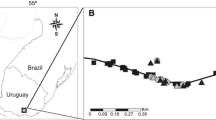Abstract
Saxifraga oppositifolia, S. biflora, and their hybridS. ×kochii were studied in a mixed population in the Swiss Alps. Qualitative morphological characters did not allow to clearly separate the hybridS. ×kochii from its parental species. All quantitative characters were intermediate inS. ×kochii, but the ranges of these characters overlapped with those ofS. oppositifolia andS. biflora. A hybrid index and canonical discriminant analysis allowed a clear separation of the three groups and strongly confirmed a priori grouping. Phenological observations showed that the three groups were not temporally separated within the investigated mixed population. Reciprocal hand pollinations betweenS. oppositifolia andS. biflora yielded higher seed set withS. oppositifolia than withS. biflora as maternal plant. Germination rate of seeds from these crossing experiments varied in the same way as seed yields, whereas germination rate was intermediate for seeds from naturally pollinatedS. ×kochii. Considering its ecological and reproductive properties,S. ×kochii has good prerequisites for evolving into a distinct species.
Similar content being viewed by others
References
Anchisi, E., 1985: Quatrième contribution à l'étude de la flore valaisanne.—Bull. Murith. Soc. Vallais. Sci. Nat.103: 115–126.
Anderson, E., Stebbins, G. L. Jr., 1954: Hybridization as an evolutionary stimulus.—Evolution8: 378–388.
Arnold, M. L., 1992: Natural hybridization as an evolutionary process.—Annual Rev. Ecol. Syst.23: 237–261.
, 1995: Are natural hybrids fit or unfit relative to their parents?—TREE10: 67–71.
Baum, Yang, J.-L., Yen, C., 1995: Taxonomic separation ofKengyilia (Poaceae: Triticeae) in relation to nearest relatedRoegneria, Elymus, andAgropyron, based on some morphological characters.—Pl. Syst. Evol.194: 123–132.
Billings, W. D., Mooney, H. A., 1968: The ecology of arctic and alpine plants.—Biol. Rev. Cambridge Philos. Soc.43: 481–529.
Bliss, L. C., 1971: Arctic and alpine plant life cycles.—Annual Rev. Ecol. Syst.2: 405–438.
Böcher, T., 1983: The allotetraploidSaxifraga nathorsti and its probable progenitorsS. aizoides andS. oppositifolia.—Meddel. Grønland (Bioscience)11: 1–22.
Brochmann, C., 1987: Evaluation of some methods for hybrid analysis, exemplified by hybridization inArgyranthemum (Asteraceae).—Nordic J. Bot.7: 609–630.
Brügger, C. G., 1881: Beobachtungen über wildwachsende Pflanzenbastarde der Schweizer-und Nachbar-Flora.—Jahresber. Naturf. Ges. Graubündens18/19: 47–123.
Crawford, R. M. M., Chapman, H. M., Abbott, R. J., Balfour, J., 1993: Potential impact of climate warming on arctic vegetation.—Flora188: 367–381.
Cruden, R. W., 1977: Pollen-ovule ratios: a conservative indicator of breeding systems in flowering plants.—Evolution31: 31–46.
Dietrich, V., 1969: Die Ophiolithe des Oberhalbsteins (Graubünden) und das Ophiolithmaterial der ostschweizerischen Molasseablagerungen, ein petrographischer Vergleich.—Diss., ETH Zürich.
Emery, R. J. N., Chinnappa, C. C., 1994: Morphological variation among members of theStellaria longipes complex:S. longipes, S. longifolia, andS. porsildii (Caryophyllaceae).—Pl. Syst. Evol.190: 69–78.
Engler, A., 1872: Monographie der GattungSaxifraga L.—Breslau: Kern.
Gower, J. C., 1971: A general coefficient of similarity and some of its properties.—Biometrics27: 857–874.
Gugerli, F., 1997: Sexual reproduction inSaxifraga oppositifolia L. andS. biflora All. (Saxifragaceae) in the Alps.—Int. J. Pl. Sci. (in press).
Heitz, C., 1990: Binz A., Schul- und Exkursionsflora für die Schweiz, 18th edn.—Basel: Schwabe.
Hess, E., Landolt, E., Hirzel, R., 1977: Flora der Schweiz und angrenzender Gebiete2. 2nd edn.—Basel: Birkhäuser.
Hörandl, E., Gutermann, W., 1994: Populationsstudien an Sippen vonSaxifraga sect.Porphyrion (Saxifragaceae) in den Alpen: I. Hybriden vonS. biflora undS. oppositifolia.—Phyton (Horn, Austria)34: 143–167.
James, F. C., McCulloch, C. E., 1990: Multivariate analysis in ecology and systematics: Panacea or Pandora's box?—Annual Rev. Ecol. Syst.21: 129–166.
Johnson, A. W., Packer, J. G., 1968: Chromosome numbers in the flora of Ogotoruk Creek, N. W. Alaska.—Bot. Not.121: 403–456.
Kaplan, K., 1995: FamilieSaxifragaceae—Steinbrechgewächse.—InWeber, H. E., (Ed.):Gustav Hegi—Illustrierte Flora von Mitteleuropa,IV/2A, pp. 130–229. 3rd edn.—Berlin: Blackwell.
Knaben, G., Engelskjøn, T., 1967: Chromosome numbers of Scandinavian arctic-alpine plant species II.—Acta Borealia, A21: 1–57.
Kudo, G., 1991: Effects of snow-free period on the phenology of alpine plants inhabiting snow patches.—Arctic Alpine Res.23: 436–443.
Küpfer, P., Rais, J.-R., 1983: Index des nombres chromosomiques des Spermatophytes de la Suisse. I.Saxifragaceae.—Bot. Helv.93: 11–25.
Lang, G., 1994: Quartäre Vegetationsgeschichte Europas.—Jena: G. Fischer.
Müller, H., 1881: Alpenblumen, ihre Befruchtung durch Insekten und ihre Anpassungen an dieselben.—Leipzig: Engelmann.
Nilsson, T., 1995: Population biology, biogeography and evolution ofSaxifraga osloensis: a polyploid plant endemic to Scandinavia.—Dissertation, University of Stockholm.
Pignatti, S., 1982: Flora d'Italia.—Bologna: Edagricole.
Rathcke, B., Lacey, E. P., 1985: Phenological patterns of terrestrial plants.—Annual Rev. Ecol. Syst.16: 179–214.
Rohlf, F. J., 1993: NTSYS-pc, numerical taxonomy and multivariate analysis system, vers. 1.80.—Setauket: Exeter Software.
Sachs, L., 1992: Angewandte Statistik, 7th edn.—Berlin: Springer.
Schröter, C., 1926: Das Pflanzenleben der Alpen, 2nd edn.—Zürich: Remstein.
Schütz, M., 1988: Genetisch-ökologische Untersuchungen an alpinen Plfanzenarten auf verschiedenen Gesteinsunterlagen: Keimungs- und Aussaatversuche.—Veröff. Geobot. Inst. ETH, Stifung Rübel Zürich99: 1–153.
Sneath, P. H. A., Sokal, R. R., 1973: Numerical taxonomy, 2nd edn.—San Francisco: Freeman.
Stace, C., (Ed.), 1975: Hybridization and the flora of the Brithsh Isles.—London: Academic Press.
Stenström, M., Molau, U., 1992: Reproductive ecology ofSaxifraga oppositifolia: phenology, mating system, and reproductive success.—Arctic Alpine Res.24: 337–343.
SYSTAT, 1992: Handbooks SYSTAT for Windows, vers. 5.—Evanston: SYSTAT.
Urbanska, K. M., Schütz, M., 1986: Reproduction by seed in alpine plants and revegetation research above timberline.—Bot. Helv.96: 43–60.
Warming, E., 1909: The structure and biology of arctic plants. IV.Saxifragaceae. 1. Morphology and biology.—Meddel. Grønland36: 171–236.
Webb, D. A., 1993:Saxifraga L.—InTutin, T. G., Burges, N. A., Chater, A. O., Edmonds, J. R., Heywood, V. H., Moore, D. M., Valentine, D. H., Walters, S. M., Webb, D. A., (Eds): Flora Europaea,1, pp. 437–458. 2nd edn.—Cambridge: Cambridge University Press.
, 1989: Saxifrages of Europe.—London: Helm.
Welten, M., Sutter, H. C., 1982: Verbreitungsatlas der Farn- und Blütenpflanzen der Schweiz,I. 2nd edn.—Basel: Birkhäuser.
Whitham, T. G., Morrow, P. A., Potts, B. M., 1991: Conservation of hybrid plants.—Science254: 779–780.
Wiens, D., 1984: Ovule survivorship, brood size, life history, breeding systems, and reproductive success in plants.—Oecologia64: 47–53.
Young, H. J., Young, T. P., 1992: Alternative outcomes of natural and experimental high pollen loads.—Ecology73: 639–647.
Author information
Authors and Affiliations
Rights and permissions
About this article
Cite this article
Gugerli, F. Hybridization ofSaxifraga oppositifolia andS. biflora (Saxifragaceae) in a mixed alpine population. Pl Syst Evol 207, 255–272 (1997). https://doi.org/10.1007/BF00984391
Received:
Revised:
Accepted:
Issue Date:
DOI: https://doi.org/10.1007/BF00984391




